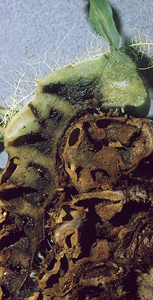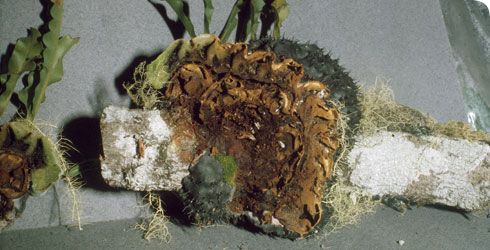Ant – fern association
Ant - fern association
All species of Lecanopteris have greatly modified rhizomes that form hollow chambers in which ants nest and raise their broods.
Although it is rare to find Lecanopteris plants with ant-free domatia, the relationship between Lecanopteris and the ants is facultative rather than obligatory. Each partner can survive without the other, though possibly survival and vigour of the plants may be affected in the absence of ants. Although the ants are not dependent on the rhizomes for nesting, they will take advantage of them whenever they are available.
Benefits to the plant
Lecanopteris plants gain nutrients and water from ants. This happens in several ways:
- ants bring into the rhizome organic matter and debris that decomposes along with their faeces and corpses, providing water and nutrients such as nitrogen that the fern can absorb through the inner rhizome walls - this method of nutrient uptake in Lecanopteris is different from that in other ant-epiphytes as there are no specialised absorptive structures within the domatium.
- in Lecanopteris spinosa, the solutes can also be taken up via roots that have penetrated the cavities - probably through old decayed leaf bases - and developed abundant root hairs.
- the fern roots on the surface of the tree branch can absorb nutrients from the carton of ‘carton runways’, continuous tunnels on the host tree trunk and branches built by ants from chewed plant material cemented with saliva. These runways allow the ants to leave the host plant safely whilst foraging on the tree, but have not been observed in association with L. spinosa.
Plants may in some cases receive protection from being eaten by insects or animals. Crematogaster are small, non-stinging ants that could see disturbance as a threat to their nests and attack when disturbed. There is, however, evidence that they do not always perform this service.
Ants probably assist spore dispersal incidentally while they are foraging.
Benefits to the ants

Section through fresh Lecanopteris spinosa rhizome showing hollow chambers. © AC Jermy
Ants have the benefit of a sheltered safe place to nest and rear their larvae. For an ant colony to thrive, cool, dry and dark conditions are needed. The hollow Lecanopteris rhizome forms a domatium (home) that provides these as:
- the rhizome chambers are dark inside
- the thick waxy epidermis and stomata-less rhizome help prevent excessive water loss and dehydration
- the internal walls of the domatia need to be moist but not wet to avoid fungal or bacterial attack - excess moisture is removed by the internal absorptive surface, so the larvae are protected from rotting
- the thick rhizomes buffer the nest and protect larvae from the high temperatures that could occur since they are sun epiphytes
Ants are found in succulent green rhizomes as well as old blackened ones and probably gain water and nutrients from the plant.
It has been reported that in some Lecanopteris species oil droplets produced in the sporangia may be harvested by ants as a source of food.
In studies of 7 Lecanopteris species, over 30 species of ants were recorded as visiting the plants, 5 of which were ‘regulars’. These were:
- Crematogaster treubi
- Crematogaster difformis
- Camponotus pallidus
- Iridomyrmex cordatus
- Iridomyrmex murinus
Within a population of Lecanopteris, or a particular geographic area or habitat, ants tend to associate with specific species. The same species of ant will colonise most Lecanopteris plants in a population throughout the life of the plants. As long as at least a small portion of the plant is living it will be inhabited by ants but totally dead plants are deserted.
Studies of other species of Lecanopteris have shown that the relationship between ants and ferns is a result of ecology not of co-evolution - when a Lecanopteris species is distributed more widely than the ants, another species of ant takes its place. Not surprisingly, the greatest range of ant species was found in the most widespread fern species, Lecanopteris sinuosa. A single ant species will colonise a range of different ant-epiphytes.
Lecanopteris spinosa was not investigated in that study but ants of the genus Crematogaster were found in L. spinosa rhizomes when they were originally collected and were deposited in the Museum's Entomology collections.
Toolbox
Glossary
Absorption
The process by which water and nutrients are absorbed and conveyed to the plant tissues and organs.
Domatium (plural: domatia)
Part of a plant that has been modified to provide protection for insects, mites or fungi.
Epiphytes
Plants that grow on another plant for support but are not parasitic.
Facultative
Not obligatory - can complete its life cycle independently.
Frond
Fern leaf.
Glaucous
With a waxy blue-green sheen.
Indusium
A structure that covers the sorus.
Monophyletic
Descended from a single common ancestor.
Rachis
A fern's midrib.
Rhizome
A fern's stem.
Sorus
Group of sporangia.
Sporangium
Spore capsule.
